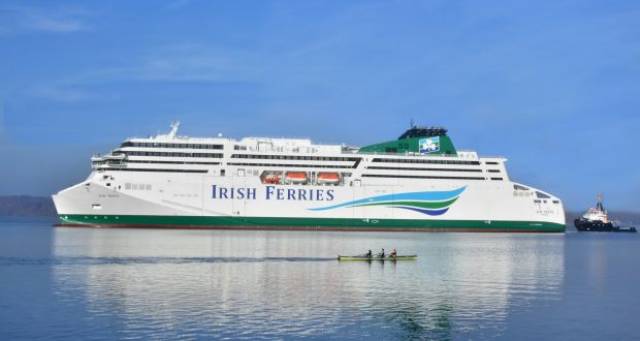#ferry - Irish Ferries W.B. Yeats which suffered delays stretching back to early summer when originally due to enter a route to France, finally departed the German shipbuilders today for Ireland but is first bound for Cherbourg, writes Jehan Ashmore.
The €147m W.B.Yeats launched by shipbuilder Flensburger Schiffbau-Gesellschaft (FSG) in Flensburg, was tracked by Afloat this afternoon as the giant Cypriot flagged cruiseferry proceeded down the Flensburg Fjord shared between German and Danish waters.
At 54,985 gross tonnage, the newbuild is the largest ever cruiseferry ordered by parent company, Irish Continental Group (ICG) which said earlier this week the new ship is due to make a delivery voyage to Dublin next week. Capacity is for 1,885 passengers accommodated in 435 cabins, including luxury suites featuring balconies is provided with a dedicated butler service. As for cars and freight trucks, there is space for 1,200 vehicles.
The delivery of the 194m cruiseferry had been delayed at the FSG shipyard which attributed the delay to receiving parts late from suppliers. This in turn led to major disruptions to holiday-makers, as sailings scheduled were cancelled on the Dublin-Cherbourg route effecting up to 19,000 passengers.
Introduction of W.B. Yeats in 2019, will see up to four sailings a week served by W.B. Yeats on the direct continental route linking Ireland and France, where the flagship will be making berthing trials in Cherbourg. Afloat understands that the newbuild is scheduled to arrive in the Normandy port on Wednesday.
The W.B. Yeats will travel 125,000 nautical miles annually, which is the equivalent of circumnavigating the globe nearly 6 times. Sailings served by the cruiseferry will begin from mid-March to the end of September, and Irish Ferries can continue to claim to be the only operator providing customers with direct crossings to mainland Europe with the convenience of Dublin Port.
W.B. Yeats becomes the first custom-built passenger car ferry, since a predecessor of ICG, the Irish Continental Line (ICL) which was semi-state owned, introduced new tonnage in the form of Saint Patrick.
This considerably smaller ferry of around 5,000 gross tonnage, and also German built, launched ICL's first season in 1973, following a gap since another concern, Normandy Ferries pulled the plug at the end of the 1971 season. There would be no service the following year, as the company cited they could no spare the ferries on the Ireland-France connection due to demands of other services.






























































